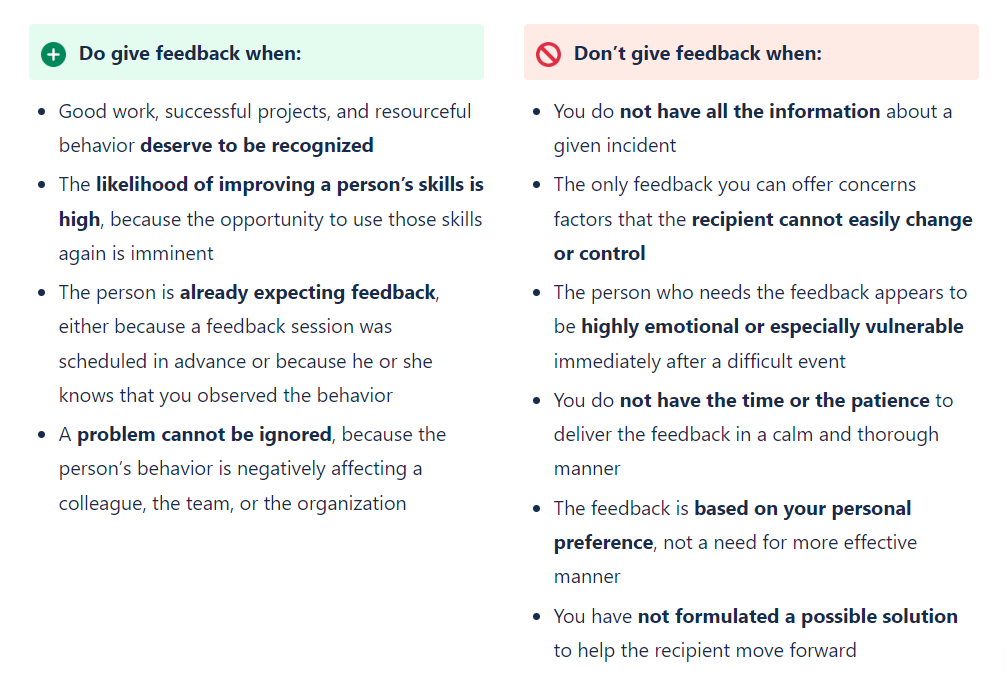How To Give Feedback
- April 28, 2023
- Author:
Frequent positive feedback helps to nurture work relationships between team members and managers. When these relationships are strong and there is trust within the team, receivers should feel less threatened and more receptive to negative feedback when it occurs.
By contrast, if feedback were only given when a problem occurred, the receiver may be more likely to experience feelings of retaliation and see the giver as unappreciative or petty.
Let us have a closer look on when to give feedback and when not to give feedback. There are certain situations you should keep in mind.

Delivering actionable feedback is essential for helping individuals and teams grow and improve their performance. Let us have a look at the do’s and don’ts:
Giving feedback in the right setting affects team performance, working relationships, and well-being. When insight concerns a team or a team goal, feedback delivered in a group setting is sometimes more productive than 1:1 feedback sessions.
Team members who are interdependent need to be able to give and receive feedback from each other. In communicating insights to each other during group feedback sessions, you have the opportunity to develop the important skill of giving feedback. Remember, feedback should also be lateral, not just top-down.
When other team members are not involved, and to avoid calling out a single team member in front of their peers, feedback should be given one-on-one.
Providing constructive feedback to a manager can be a sensitive and challenging process, but it can also lead to positive changes in their leadership style and benefit the entire team.
While receiving recognition and approval feels good, it’s not always easy to receive critical feedback. It may trigger anxiety, frustration, or defensiveness. Understanding our natural responses to feedback is key to learning how best to give, as well as receive it.
Often, receiving feedback, especially critical feedback, is a visceral experience that manifests in our minds, bodies, and emotions.
Receiving critical feedback can sometimes trigger a negativity bias, which is the universal tendency for negative events and emotions to affect us more strongly than positive ones.
Though critical feedback isn’t always easy to hear, it is always for your benefit. Thankfully, receiving feedback with clarity of mind involves learnable skills, such as identifying and addressing the three feedback triggers.
Productively processing feedback requires continuous reflection and conversation. Most of all, it requires practice, especially when it comes to identifying and managing emotions and extracting value from criticism, even when poorly delivered.
When going into a feedback session, receive feedback without judgment, neither agreeing or rejecting it. Be aware of any emotional feelings that might occur, but do not act on them.
If you receive vague feedback, ask the giver to clarify what they were commenting on. If positive, you’ll know to continue this behavior. If negative, ask for the giver to be more specific in the feedback. What could be done differently?
Let the feedback metabolize and consider how it makes you feel.
Be objective as you ask yourself why you might have received this feedback.
Remember, you won’t be able to immediately fix the problem. It will take time and practice, so don’t be hard on yourself if the change doesn’t occur all at once.
Once you’ve begun to implement feedback, ask your leaders and other people who are impacted by the feedback if they have experienced a difference since you’ve begun implementing changes.
Keeping all these feedback aspects in mind, will help to introduce a healthy feedback culture in remote companies.
Feedback should be given consistently, and it should mostly be positive. Remember that feedback is more than the words you speak. Different elements of personal communication and the relationship between giver and receiver influence feedback and the way it is perceived.